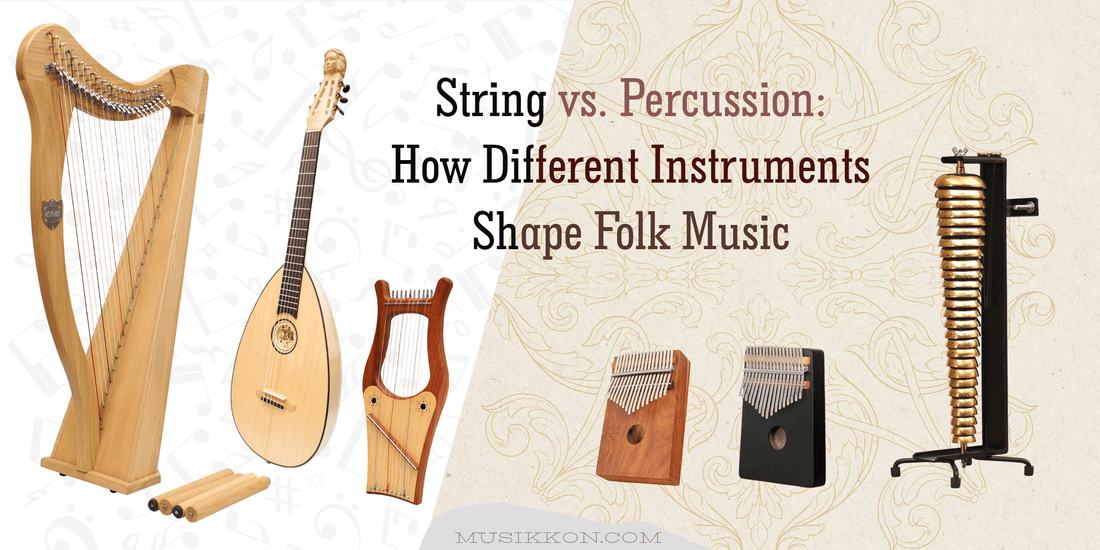Folk music has always been a reflection of people’s stories, celebrations, and traditions. The sound of this music is shaped not only by voices but also by the instruments that bring rhythm and melody to life. Among these, string instruments and percussion instruments stand out as two families that give folk music its distinct identity. At Muzikkon, where you’ll find instruments like Lyre Harps, Renaissance Lutes, Kinnor Harps, Banjos, Ukuleles, Bodhráns, and Kalimbas, the importance of these traditions is clear.
This post explores how strings and percussion shape folk music across cultures, why both are essential, and how together they keep traditions alive.

The Melodic Voice of Strings
String instruments are often at the center of folk traditions because they carry the melody. From ballads sung with a lute in medieval Europe to lively banjo tunes in American bluegrass, strings provide both harmony and emotional depth.
Instruments like the Renaissance Lute and Kinnor Harps remind us of the long history of plucked strings, where musicians would accompany stories and poetry. The lyre harp, with its bright and delicate tone, has been used since ancient times in ceremonial and communal settings. These instruments remain a favorite for players who want to reconnect with the roots of traditional music.
More portable options like the Ukuleles and Banjo shaped the sound of folk gatherings around the world. Their bright tones made them perfect for dances and storytelling sessions. Strings don’t just provide melody, they also bring rhythm. A steady strum or drone creates a foundation that supports singers and dancers, making the music complete.

🔗 Shop At Muzikkon
The Heartbeat of Percussion
If strings speak to the emotions, percussion speaks to the body. Drums, shakers, and frame instruments set the pulse of folk music, encouraging movement and participation. Across cultures, percussion instruments have been tied to rituals, dances, and celebrations, giving structure to community gatherings.
In Irish traditions, the Bodhrán is a standout. Played with a wooden tipper, it produces a resonant beat that drives jigs and reels. The sound can be deep and powerful or sharp and playful, depending on how the skin is struck and controlled. Similar frame drums appear across the Mediterranean, Middle East, and Africa, showing just how widespread percussion is in folk life.
Other instruments blur the line between rhythm and melody. The Kalimbas, often called the thumb piano, is technically a percussion instrument but creates sweet, melodic tones when its tines are plucked. It’s a perfect example of how percussion can add not just rhythm but also a unique melodic character to folk music.
Even simple percussive elements such as hand clapping or foot stomping are a vital part of folk performance. They emphasize that percussion is not just about instruments but about the collective act of keeping time and sharing rhythm.

Strings and Percussion Together
The most memorable folk performances often combine Strings and Percussion. Imagine the rolling beat of a Bodhrán underneath the flowing melody of a Harp, or the lively pluck of a Banjo supported by the tapping rhythm of spoons or a Drum. The interplay between melody and rhythm is what gives folk music its energy and emotional pull.
Different cultures emphasize one family over the other, but balance is usually present. In some communities, string instruments dominate, carrying long ballads with only subtle rhythmic support. In others, Percussion leads the way, with dancers and drummers creating the main energy while Strings weave in color and tune. Both approaches highlight the role of instruments in shaping how folk music feels and how it is experienced by a community.
Keeping Traditions Alive
Instruments are more than tools for making music. They are cultural symbols, connecting people to their history and identity. The harp is an emblem of Irish tradition, just as the Banjo is linked with American folk heritage. By playing these instruments, musicians keep centuries-old traditions alive while also adapting them for modern audiences.
At Muzikkon, the variety of string instruments and percussion instruments available gives musicians the chance to explore both sides of folk music. Whether it’s the resonance of a Lyre Harp, the bright rhythm of a Banjo, or the deep pulse of a Bodhrán, each instrument offers a doorway into understanding how folk traditions are built on sound.
Final Thoughts
Folk music is shaped by the partnership of Strings and Percussion. Strings give voice to melody and storytelling, while percussion provides the heartbeat that moves communities together. Each family has its role, but together they create the layered, dynamic sound that defines folk traditions across the world.
Exploring instruments like those available At Muzikkon – from Kinnor Harps to Bodhrán – is not just about playing music, it is about experiencing history and carrying these traditions forward. Strings speak to the heart; Percussion speaks to the body. Together, they keep the spirit of folk music alive.

